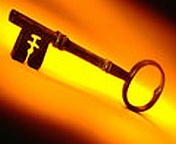
The Key of David
Unlocking Biblical Scriptures
Used twice in Scripture (Isa 22:22 & Rev 3:7), the phrase Key of David refers to possessing legitimate authority to rule Israel, the holy nation of God. The Key of David doesn’t refer to a physical throne or to a physical nation. “Israel” is the woman of Revelation chapter 12. She goes from being the physical nation that gave birth to Christ Jesus (v. 5) to the spiritual nation whose offspring keep the commandments of God and hold the testimony of Jesus (v. 17), which is the spirit of prophecy (Rev 19:10). Israel will become the single great nation promised to the patriarch Abraham (Gen 12:2) when the kingdom of the world becomes the kingdom of the Most High and of His Christ (Rev 11:15-18; Dan 7:9-14).
But the Key of David means more than who has the right to rule Israel.
The Key of David is the key that unlocks Scripture: it means understanding the writings of King David, a man after God’s heart, a man who used the outside/inside movement of Hebraic poetics to simultaneously reveal and conceal knowledge. David’s use of repetition to form couplets within David’s songs, a poetic style he inherited, functions to marry the visible to the invisible, thereby causing the visible to become a copy and shadow of the invisible (Heb 8:5 et al). The poetic movement captured within the thought couplets is from darkness to light, from night to day, from death to life, from hand to heart, from society to individual, from the natural nation of Israel to the spiritual nation of Israel, from the authority to reign over the natural nation (Isa 22:22) to the authority to reign over the spiritual nation (Rev 3:7). The Key of David uses typology to unlock sealed and secret prophecies, to reveal the mysteries of God, and to hide these secret things of God from the natural nation of Israel that saw only with eyes and heard only with ears.
The movement from natural to spiritual, from darkness to light is used throughout Holy Writ to prevent understanding the mysteries of God before the end of the age. It is the key to understanding the scriptural inclusion of one event and the exclusion of another, for what has been included forms the visible shadow of what cannot be seen in the supra-dimensional heavenly realm. Therefore, the first man Adam is a type and shadow of a last Adam (Rom 5:14), and the history of the natural nation of Israel in Judea forms the shadow of the Church in the heavenly realm.
So the Key of David is not a little key that unlocks the throne of Britain, or identifies where descendants of the ancient house of Israel dwell at the end of the age. It has nothing to do with mysticism, or with any allegedly essential endtime man. This Key of David isn’t given just to The Philadelphia Church, the fellowship that has done most of the early work of unlocking the mysteries of God. Rather, the Key of David involves using typological exegesis to take meaning from Scripture.
Comprehending both the text and the texture of Scripture causes born anew disciples processing the Key of David to realize that the focus of Hebraic poetry ultimately isn’t the linguistic objects [signifieds] assigned mimetically (i.e., what the words seem to describe), but the words themselves as artifices that exist in a mental landscape analogous to the physical geography of antediluvian Eden. The juxtaposition of humanity’s mental topography with the regional geography of the Near and Middle East allows human beings to see darkly into a dimension that they cannot otherwise enter to take measurements or to make observations—allows humankind to visibly see sin [lawlessness] and death and the landscape that must be traversed to enter into God’s rest (Ps 95:10-11). Hence, the Key of David makes apparent the correspondence between a physically circumcised Israelite dwelling in physical Judea, living under the laws of God written on two stone tablets, and a spiritually circumcised Israelite observing the Sabbath, living under the laws of God written on two fleshy tablets, with both Judea (Heb 3:19) and the 7th-day Sabbath representing the type of [as in the geography of Judean hillsides] God’s rest, its diminutive form (Heb 4:9-10).
The rest that Joshua gave the natural nation (vv. 3-8) was a certain physical landscape Beyond the River Jordan whereas the rest Jesus gave the spiritual nation is the Sabbath, a copy and shadow of entrance into the heavenly realm, a landscape beyond the physical creation.
Homer Kizer MinistriesPO Box 1917
Adak, AK 99546
(907)572-6118
email: HKMinistries@homerkizer.org